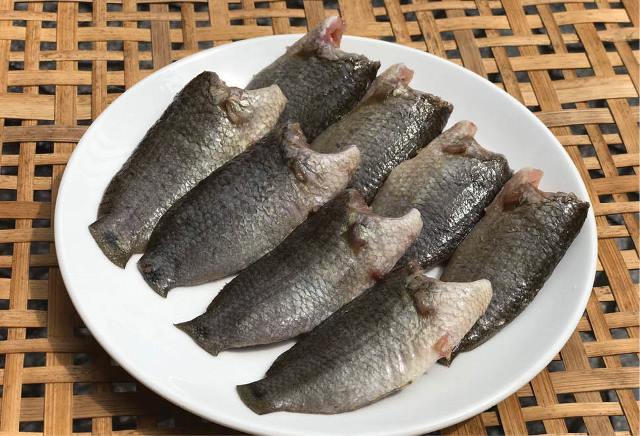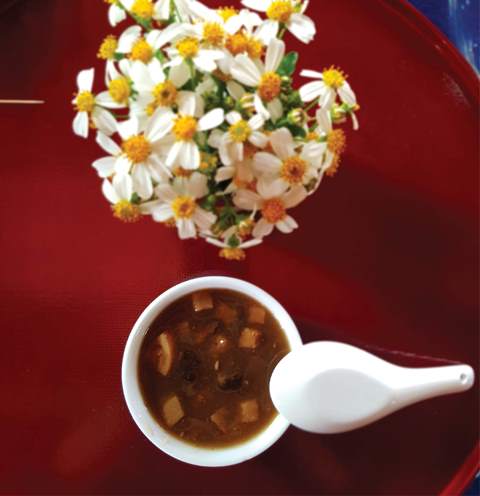
Field anabas is processed in three steps before cooked into che.
Mr. Nguyen Phuc Ung Vien, a grandson of the emperor Minh Mang’s 12th prince, who is keeping many royal medicinal secrets, cooked che ca ro dong for guests as evidence for the quintessence of che Hue.
"This che belongs to the “royal salty group.” Each group has 5 different kinds. The flavors are adjusted in accordance with the season to suit the taste of the diner. It is upgraded to become dietary supplement, helping blood circulation and good for the heart and the brain.” “This is one of the dishes which was recorded and handed down by the royal family branch of Mr. Ung Vien," said Mr. Ta Tri currently living in Ho Chi Minh City, who had had the chance to taste it.
Legend has it that when Lord Nguyen Anh arrived in Go Cong (now belonging to Tien Giang Province), he was invited by a woman a bowl of che ca ro dong cooked with cane sugar. To recall his difficult days, the first emperor of the Nguyen dynasty had the Medical Institute research and combine ingredients to upgrade it to become a dish for national banquets.
Che ca ro dong consists of anabas, egg, and pork (cheek meat). A good cook can tell the ingredients when tasting it, but in order to have a bowl of che that is both beautiful and medicinal, he needs to follow the recipe and know how to combine ingredients to perfection.
After Mr. Ung Vien passed away, people though that the recipe was gone with him. Luckily enough, it has an heir.

Che ca ro dong is considered the most perfect combination of ingredients and medicinal materials.
This more-than-200-year-old sweet dish was cooked for a few close guests by Tran Thanh Quang, a Hue local and student of Mr. Ung Vien. "Although it is not easy to eat if you try it for the first time, you will become addicted without knowing with time. Its taste is so strange,” recalled Thanh Mai after her first time of tasting the dish.
To enjoy che ca ro dong the diner often eats just a little bit at a time, partly because he is embarrassed, partly because he does not want to finish it soon. The flesh of anabas is chewy and fragrant, the pork cubes are crispy, and the chicken egg is soft and fatty. It is as if the five senses were awakened when you enjoy it.
The ingredients are high in protein, but it does not smell fishy, and the taste lingers on the tip of the tongue. It is thanks to the mint and tea which drives away the fishy smell and leave a pleasant aftertaste. That sticky che is just sweet enough whether eaten hot or cold. It is because of cane sugar and arrowroot starch. Some other secret medicinal materials are added to make the unique sweet dish which surprises those who taste it.
“The field anabas goes through three processing stages. This dish needs fermented velvet beans which require three to four months for them to ferment. People need 3 hours to cook this dish and it must be made in a processed earthen pot.” This royal che proves our ancestors’ utmost meticulousness in research and cuisine.
Considered in terms of eastern medicine, field anabas is sweet and “average” (neither “hot” nor “cold”), good for blood and for burned-out people. Chicken egg is wholesome and “average,” and cures fevers, coughs, and flu. Velvet beans are inherently toxic but used properly, they help warm the body up, reduce heartburn or hiccups, and treat diarrhea.
Listing some ingredients to see how their combination and adjustment strengthen their medicinal effects to improve health and to detoxify the body. That is the result of a long process of selection and inheritance.
Che ca ro dong is so strange and special, but very few materials mention it. According to Mr. Truong Ngoc Tuong, a well-known Southern cultural researcher, it may be a folk story, or a private secret recipe of the imperial court.
The heritage of the Nguyen dynasty, which lasted for more than 140 years, contains many mysteries preserved by its descendants only. They will disappear soon if we do not plan to conserve them.
Che ca ro only can tell an interesting culinary story. In order to have such perfect che ca ro dong, one needed the continuity, analysis, synthesis, adjustment, and combination of ingredients and spices.
So do not ask why Hue dishes are so sophisticated. Some dishes are just some bites or some small spoons, but they contain in themselves lots of knowledge, techniques, and even the quintessence of the whole dynasty. As of now, if you want to enjoy a bowl of che ca ro dong, you have to wait at least a couple of months for velvet beans to ferment.
Story and photos: LINH TUE